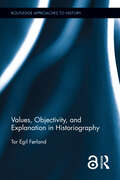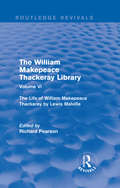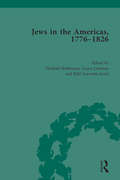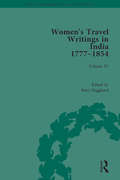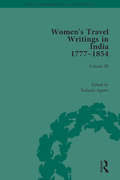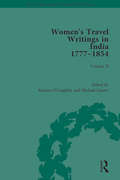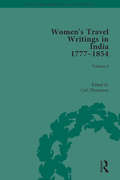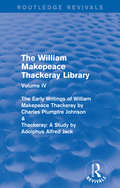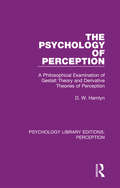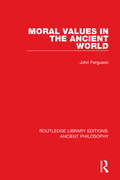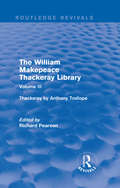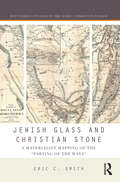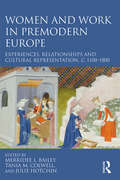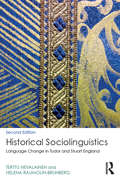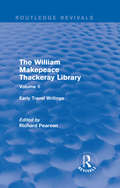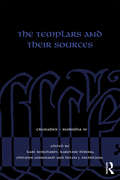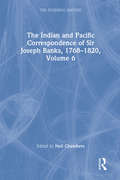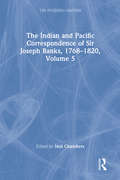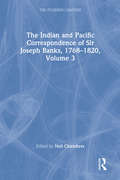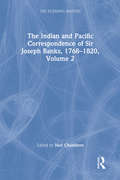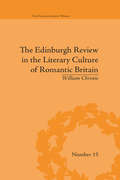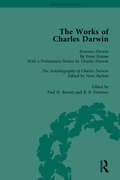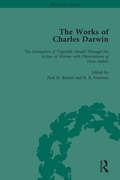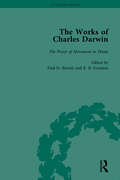- Table View
- List View
Values, Objectivity, and Explanation in Historiography (Routledge Approaches to History #21)
by Tor Egil FørlandBringing sophisticated philosophy to bear on real-life historiography, Values, Objectivity, and Explanation in Historiography rekindles and invigorates the debate on two perennials in the theory and methodology of history. One is the tension between historians' values and the ideal—or illusion—of objective historiography. The other is historical explanation. The point of departure for the treatment of values and objectivity is an exceptionally heated debate on Cold War historiography in Denmark, involving not only historians but also the political parties, the national newspapers, and the courts. The in-depth analysis that follows concludes that historians can produce accounts that deserve the label "objective," even though their descriptions are tinged by ineluctable epistemic instability. A separate chapter dissects the postmodern notion of situated truths. The second part of the book proffers a new take on historical explanation. It is based on the notion of the ideal explanatory text, which allows for not only causal—including intentional—but also nomological, structural, and functional explanations. The approach, which can accommodate narrative explanations driven by causal plots, is ecumenical but not all-encompassing. Emergent social properties and supernatural entities are excluded from the ideal explanatory text, making scientific historiography methodologically individualistic—albeit with room for explanations at higher levels when pragmatically justified—and atheist.
The William Makepeace Thackeray Library: Volume VI - The Life of William Makepeace Thackeray by Lewis Melville (Routledge Revivals: The William Makepeace Thackeray Library)
by Richard PearsonFirst published in 1996, The William Makepeace Thackeray Library is a collection of works written by and about the novelist. This sixth volume contains the work of Lewis Melville, one of the most productive biographers and critics of Thackeray at the turn of the 20th century. Richard Pearson’s helpful introduction not only provides additional information on the biographer himself, but also analyses the text and tracks its development over time. This book will be of interest to those studying Thackeray and nineteenth-century literature.
Jews in the Americas, 1776-1826 (Routledge Historical Resources)
by Michael Hoberman Laura Leibman Hilit Surowitz-IsraelThe period between 1776-1826 signalled a major change in how Jewish identity was understood both by Jews and non-Jews throughout the Americas. Jews in the Americas, 1776-1826 brings this world of change to life by uniting important out-of-print primary sources on early American Jewish life with rare archival materials that can currently be found only in special collections in Europe, England, the United States, and the Caribbean.
Women's Travel Writings in India 1777–1854: Volume IV: Mary Martha Sherwood, The Life of Mrs Sherwood (1854) (Chawton House Library: Women’s Travel Writings)
by Betty HagglundThe ‘memsahibs’ of the British Raj in India are well-known figures today, frequently depicted in fiction, TV and film. In recent years, they have also become the focus of extensive scholarship. Less familiar to both academics and the general public, however, are the eighteenth- and early nineteenth-century precursors to the memsahibs of the Victorian and Edwardian era. Yet British women also visited and resided in India in this earlier period, witnessing first-hand the tumultuous, expansionist decades in which the East India Company established British control over the subcontinent. Some of these travellers produced highly regarded accounts of their experiences, thereby inaugurating a rich tradition of women’s travel writing about India. In the process, they not only reported events and developments in the subcontinent, they also contributed to them, helping to shape opinion and policy on issues such as colonial rule, religion, and social reform. This new set in the Chawton House Library Women’s Travel Writing series assembles seven of these accounts, six by British authors (Jemima Kindersley, Maria Graham, Eliza Fay, Ann Deane, Julia Maitland and Mary Sherwood) and one by an American (Harriet Newell). Their narratives – here reproduced for the first time in reset scholarly editions – were published between 1777 and 1854, and recount journeys undertaken in India, or periods of residence there, between the 1760s and the 1830s. Collectively they showcase the range of women’s interests and activities in India, and also the variety of narrative forms, voices and personae available to them as travel writers. Some stand squarely in the tradition of Enlightenment ethnography; others show the growing influence of Evangelical beliefs. But all disrupt any lingering stereotypes about women’s passivity, reticence and lack of public agency in this period, when colonial women were not yet as sequestered and debarred from cross-cultural contact as they would later be during the Raj. Their narratives are consequently a useful resource to students and researchers across multiple fields and disciplines, including women’s writing, travel writing, colonial and postcolonial studies, the history of women’s educational and missionary work, and Romantic-era and nineteenth-century literature. This final volume reproduces a text by Mary Sherwood, called The Life of Mrs Sherwood (1854).
Women's Travel Writings in India 1777–1854: Volume III: Mrs A. Deane, A Tour through the Upper Provinces of Hindustan (1823); and Julia Charlotte Maitland, Letters from Madras During the Years 1836-39, by a Lady (1843) (Chawton House Library: Women’s Travel Writings)
by Éadaoin AgnewThe ‘memsahibs’ of the British Raj in India are well-known figures today, frequently depicted in fiction, TV and film. In recent years, they have also become the focus of extensive scholarship. Less familiar to both academics and the general public, however, are the eighteenth- and early nineteenth-century precursors to the memsahibs of the Victorian and Edwardian era. Yet British women also visited and resided in India in this earlier period, witnessing first-hand the tumultuous, expansionist decades in which the East India Company established British control over the subcontinent. Some of these travellers produced highly regarded accounts of their experiences, thereby inaugurating a rich tradition of women’s travel writing about India. In the process, they not only reported events and developments in the subcontinent, they also contributed to them, helping to shape opinion and policy on issues such as colonial rule, religion, and social reform. This new set in the Chawton House Library Women’s Travel Writing series assembles seven of these accounts, six by British authors (Jemima Kindersley, Maria Graham, Eliza Fay, Ann Deane, Julia Maitland and Mary Sherwood) and one by an American (Harriet Newell). Their narratives – here reproduced for the first time in reset scholarly editions – were published between 1777 and 1854, and recount journeys undertaken in India, or periods of residence there, between the 1760s and the 1830s. Collectively they showcase the range of women’s interests and activities in India, and also the variety of narrative forms, voices and personae available to them as travel writers. Some stand squarely in the tradition of Enlightenment ethnography; others show the growing influence of Evangelical beliefs. But all disrupt any lingering stereotypes about women’s passivity, reticence and lack of public agency in this period, when colonial women were not yet as sequestered and debarred from cross-cultural contact as they would later be during the Raj. Their narratives are consequently a useful resource to students and researchers across multiple fields and disciplines, including women’s writing, travel writing, colonial and postcolonial studies, the history of women’s educational and missionary work, and Romantic-era and nineteenth-century literature. This volume includes two texts, Ann Deane, A Tour Through the Upper Provinces of Hindostan (1823) and Julia Maitland, Letters from Madras (1846).
Women's Travel Writings in India 1777–1854: Volume II: Harriet Newell, Memoirs of Mrs Harriet Newell, Wife of the Reverend Samuel Newell, American Missionary to India (1815); and Eliza Fay, Letters from India (1817) (Chawton House Library: Women’s Travel Writings)
by Michael Gamer Katrina O’LoughlinThe ‘memsahibs’ of the British Raj in India are well-known figures today, frequently depicted in fiction, TV and film. In recent years, they have also become the focus of extensive scholarship. Less familiar to both academics and the general public, however, are the eighteenth- and early nineteenth-century precursors to the memsahibs of the Victorian and Edwardian era. Yet British women also visited and resided in India in this earlier period, witnessing first-hand the tumultuous, expansionist decades in which the East India Company established British control over the subcontinent. Some of these travellers produced highly regarded accounts of their experiences, thereby inaugurating a rich tradition of women’s travel writing about India. In the process, they not only reported events and developments in the subcontinent, they also contributed to them, helping to shape opinion and policy on issues such as colonial rule, religion, and social reform. This new set in the Chawton House Library Women’s Travel Writing series assembles seven of these accounts, six by British authors (Jemima Kindersley, Maria Graham, Eliza Fay, Ann Deane, Julia Maitland and Mary Sherwood) and one by an American (Harriet Newell). Their narratives – here reproduced for the first time in reset scholarly editions – were published between 1777 and 1854, and recount journeys undertaken in India, or periods of residence there, between the 1760s and the 1830s. Collectively they showcase the range of women’s interests and activities in India, and also the variety of narrative forms, voices and personae available to them as travel writers. Some stand squarely in the tradition of Enlightenment ethnography; others show the growing influence of Evangelical beliefs. But all disrupt any lingering stereotypes about women’s passivity, reticence and lack of public agency in this period, when colonial women were not yet as sequestered and debarred from cross-cultural contact as they would later be during the Raj. Their narratives are consequently a useful resource to students and researchers across multiple fields and disciplines, including women’s writing, travel writing, colonial and postcolonial studies, the history of women’s educational and missionary work, and Romantic-era and nineteenth-century literature. This second volume includes two texts, Harriet Newell, Memoirs of Mrs Harriet Newell (1815) and Eliza Fay, Original Letters from India (1817).
Women's Travel Writings in India 1777–1854: Volume I: Jemima Kindersley, Letters from the Island of Teneriffe, Brazil, the Cape of Good Hope and the East Indies (1777); and Maria Graham, Journal of a Residence in India (1812) (Chawton House Library: Women’s Travel Writings)
by Carl ThompsonThe ‘memsahibs’ of the British Raj in India are well-known figures today, frequently depicted in fiction, TV and film. In recent years, they have also become the focus of extensive scholarship. Less familiar to both academics and the general public, however, are the eighteenth- and early nineteenth-century precursors to the memsahibs of the Victorian and Edwardian era. Yet British women also visited and resided in India in this earlier period, witnessing first-hand the tumultuous, expansionist decades in which the East India Company established British control over the subcontinent. Some of these travellers produced highly regarded accounts of their experiences, thereby inaugurating a rich tradition of women’s travel writing about India. In the process, they not only reported events and developments in the subcontinent, they also contributed to them, helping to shape opinion and policy on issues such as colonial rule, religion, and social reform. This new set in the Chawton House Library Women’s Travel Writing series assembles seven of these accounts, six by British authors (Jemima Kindersley, Maria Graham, Eliza Fay, Ann Deane, Julia Maitland and Mary Sherwood) and one by an American (Harriet Newell). Their narratives – here reproduced for the first time in reset scholarly editions – were published between 1777 and 1854, and recount journeys undertaken in India, or periods of residence there, between the 1760s and the 1830s. Collectively they showcase the range of women’s interests and activities in India, and also the variety of narrative forms, voices and personae available to them as travel writers. Some stand squarely in the tradition of Enlightenment ethnography; others show the growing influence of Evangelical beliefs. But all disrupt any lingering stereotypes about women’s passivity, reticence and lack of public agency in this period, when colonial women were not yet as sequestered and debarred from cross-cultural contact as they would later be during the Raj. Their narratives are consequently a useful resource to students and researchers across multiple fields and disciplines, including women’s writing, travel writing, colonial and postcolonial studies, the history of women’s educational and missionary work, and Romantic-era and nineteenth-century literature. This volume includes 2 texts, Jemima Kindersley, Letters from the Island of Teneriffe, Brazil, the Cape of Good Hope, and the East Indies (1777) and Maria Graham, Journal of a Residence in India (1812).
The William Makepeace Thackeray Library: Volume IV - The Early Writings of William Makepeace Thackeray by Charles Plumptre Johnson & Thackeray: A Study by Adolphus Alfred Jack (Routledge Revivals: The William Makepeace Thackeray Library #4)
by Richard PearsonFirst published in 1996, The William Makepeace Thackeray Library is a collection of works written by and about the novelist. This fourth volume contains Charles Plumptre Johnson’s The Early Writings of William Makepeace Thackeray and Adolphus Alfred Jack’s Thackeray: A Study. While Johnson’s work signifies a landmark in Thackeray scholarship, recognizing his lesser-known work for magazines and newspapers, A. A. Jack’s text marks a major reassessment of Thackeray’s work in light of the debate on the moral intentionality of fiction. Richard Pearson’s introduction guides the reader through the context of each publication, providing a helpful explanation of how and why these works were written. This book will be of interest to those studying Thackeray and nineteenth-century literature.
The Psychology of Perception: A Philosophical Examination of Gestalt Theory and Derivative Theories of Perception (Psychology Library Editions: Perception #13)
by D. W. HamlynOriginally published in 1957, the primary aim of this study was to shed light upon the logical character of the psychology of perception. D.W. Hamlyn begins by delimiting the field of psychological inquiry into perception, then gives a detailed account of the types of explanation appropriate in the field. He maintains that these explanations have certain important peculiarities which distinguish them from other scientific inquiries. In view of the central importance of Gestalt Theory in this field an account is given of its origins, and its main features are critically discussed. The work should still be of considerable interest to both philosophers and psychologists, as well as to all those interested in the relations between the two subjects.
Moral Values in the Ancient World (Routledge Library Editions: Ancient Philosophy)
by John FergusonThis book studies the pilgrimage of the Ancient World in its search for moral truth. After a brief examination of the values which dominated Homeric society and the subsequent aristocracies, the central portion of the book is an account and analysis of the moral ideas which illuminated the Greek, Roman and Hebrew worlds during the classical period. The volume discusses the cardinal virtues, the place of friendship, Plato’s love, philanthropia and the moral insights of the Jewish prophets and subsequently examines Christian love.
Moral Values in the Ancient World (Routledge Library Editions: Ancient Philosophy)
by John FergusonThis book studies the pilgrimage of the Ancient World in its search for moral truth. After a brief examination of the values which dominated Homeric society and the subsequent aristocracies, the central portion of the book is an account and analysis of the moral ideas which illuminated the Greek, Roman and Hebrew worlds during the classical period. The volume discusses the cardinal virtues, the place of friendship, Plato’s love, philanthropia and the moral insights of the Jewish prophets and subsequently examines Christian love.
The William Makepeace Thackeray Library: Volume III - Thackeray by Anthony Trollope (Routledge Revivals: The William Makepeace Thackeray Library)
by Anthony Trollope and Richard PearsonFirst published in 1996, The William Makepeace Thackeray Library is a collection of works written by and about the novelist. This third volume contains Anthony Trollope’s volume on Thackeray from John Morley’s series entitled The English Men of Letters. The work signifies Thackeray’s move to perceived respectability, placing him as part of the literary establishment, alongside writers such as Spenser, Johnson, Milton, Chaucer, Pope and Wordsworth. The introduction by Richard Pearson outlines the context in which the volume was written and received, including Trollope and Thackeray’s relationship and the book’s critical reception. This book will be of interest to those studying Thackeray and nineteenth-century literature.
Jewish Glass and Christian Stone: A Materialist Mapping of the "Parting of the Ways" (Routledge Studies in the Early Christian World)
by Eric C. SmithIn recent years scholars have re-evaluated the "parting of the ways" between Judaism and Christianity, reaching new understandings of the ways shared origins gave way to two distinct and sometimes inimical religious traditions. But this has been a profoundly textual task, relying on the writings of rabbis, bishops, and other text-producing elites to map the terrain of the "parting." This book takes up the question of the divergence of Judaism and Christianity in terms of material--the stuff made, used, and left behind by the persons that lived in and between these religions as they were developing. Considering the glass, clay, stone, paint, vellum, and papyrus of ancient Jews and Christians, this book maps the "parting" in new ways, and argues for a greater role for material and materialism in our reconstructions of the past.
Women and Work in Premodern Europe: Experiences, Relationships and Cultural Representation, c. 1100-1800
by Merridee L. Bailey Tania M. Colwell Julie HotchinThis book re-evaluates and extends understandings about how work was conceived and what it could entail for women in the premodern period in Europe from c. 1100 to c. 1800. It does this by building on the impressive growth in literature on women’s working experiences, and by adopting new interpretive approaches that expand received assumptions about what constituted 'work' for women. While attention to the diversity of women’s contributions to the economy has done much to make the breadth of women’s experiences of labour visible, this volume takes a more expansive conceptual approach to the notion of work and considers the social and cultural dimensions in which activities were construed and valued as work. This interdisciplinary collection thus advances concepts of work that encompass cultural activities in addition to more traditional economic understandings of work as employment or labour for production. The chapters reconceptualise and explore work for women by asking how the working lives of historical women were enacted and represented, and analyse the relationships that shaped women’s experiences of work across the European premodern period.
Historical Sociolinguistics: Language Change in Tudor and Stuart England (Longman Linguistics Library #8)
by Terttu Nevalainen Helena Raumolin-BrunbergHistorical Sociolinguistics: Language Change in Tudor and Stuart England is the seminal text in the field of historical sociolinguistics. Demonstrating the real-world application of sociolinguistic research methodologies, this book examines the social factors which promoted linguistic changes in English, laying the foundation for Modern Standard English. This revised edition of Nevalainen and Raumolin-Brunberg’s ground-breaking work: discusses the grammatical developments that shaped English in the early modern period; presents the sociolinguistic factors affecting linguistic change in Tudor and Stuart English, including gender, social status, and regional variation; showcases the authors’ research into personal letters from the people who were the driving force behind these changes; and demonstrates how historical linguists can make use of social and demographic history to analyse linguistic variation over an extended period of time. With brand new chapters on language change and the individual, and on newly developed sociolinguistic research methods, Historical Sociolinguistics is essential reading for all students and researchers in this area.
The William Makepeace Thackeray Library: Volume II - Early Travel Writings (Routledge Revivals: The William Makepeace Thackeray Library)
by Richard PearsonFirst published in 1996, The William Makepeace Thackeray Library is a collection of works written by and about the novelist. William Makepeace Thackeray spent part of virtually every year of his writing life in Paris and he wrote continually on France and French culture. This volume contains a selection of Thackeray’s travel writing, the majority of which centres around his time spent in France, with the addition of some writing on his travels to Germany and America. With an explanatory introduction by Richard Pearson, this book reveals some of Thackeray’s lesser-known work which would later inform his novels. This book will be of interest to those studying Thackeray and nineteenth-century travel writing and literature.
The Templars and their Sources (Crusades - Subsidia)
by Karl Borchardt Karoline Döring Philippe Josserand Helen J NicholsonEven 700 years after the suppression of the Order of the Temple and the execution of the last grandmaster, Jacques de Molay, there is no shortage of publications on this influential military order. Yet unlike other medieval institutions the Templars are subject to speculative fiction and popular myth which threaten to swamp the fruits of scholarly endeavour. Fortunately, recent years have produced a thriving academic scholarship which is challenging these myths. More and more sources are currently being edited, particularly those for the trial of the Templars (1307–1312). Others are still awaiting indepth study, among them, surprisingly, the greater part of the charters that cover more than 150 years of the Order’s history. The papers in this volume step into this gap and critically evaluate new directions in Templar studies on the basis of as-yet unedited source material. Open issues and desiderata regarding the sources are discussed and from a range of inspiring results a new status quaestionis is proposed that will not only provide a better understanding of the Order’s archaeological, economical, religious, administrative and military history, but also set new points of departure for the editing of charters and administrative documents. The papers here are grouped into six sections, focusing on the headquarters of the Order, its charters, manpower and finance, religious life and finally the suppression and the Order’s afterlife.
The Indian and Pacific Correspondence of Sir Joseph Banks, 1768–1820, Volume 6 (The Pickering Masters)
by Neil ChambersFollowing his participation in James Cook's circumnavigation in HMS Endeavour (1768-71), Joseph Banks developed an extensive global network of scientists and explorers. His correspondence shows how he developed effective working links with the British Admiralty and with the generation of naval officers who sailed after Cook. Volume 6 Letters 1801–1805
The Indian and Pacific Correspondence of Sir Joseph Banks, 1768–1820, Volume 5 (The Pickering Masters)
by Neil ChambersFollowing his participation in James Cook's circumnavigation in HMS Endeavour (1768-71), Joseph Banks developed an extensive global network of scientists and explorers. His correspondence shows how he developed effective working links with the British Admiralty and with the generation of naval officers who sailed after Cook. Volume 5 Letters 1798–1801
The Indian and Pacific Correspondence of Sir Joseph Banks, 1768–1820, Volume 3 (The Pickering Masters)
by Neil ChambersFollowing his participation in James Cook's circumnavigation in HMS Endeavour (1768-71), Joseph Banks developed an extensive global network of scientists and explorers. His correspondence shows how he developed effective working links with the British Admiralty and with the generation of naval officers who sailed after Cook. Volume 3 Letters 1789–1792
The Indian and Pacific Correspondence of Sir Joseph Banks, 1768–1820, Volume 2 (The Pickering Masters)
by Neil ChambersFollowing his participation in James Cook's circumnavigation in HMS Endeavour (1768-71), Joseph Banks developed an extensive global network of scientists and explorers. His correspondence shows how he developed effective working links with the British Admiralty and with the generation of naval officers who sailed after Cook. Volume 2 1768–1820.
The Edinburgh Review in the Literary Culture of Romantic Britain: Mammoth and Megalonyx (The Enlightenment World #15)
by William ChristieFrom its first issue, published on the 10th October 1802, Francis Jeffrey's "Edinburgh Review" established a strong reputation and exerted a powerful influence. This is a literary study of the "Edinburgh Review" for over fifty years. It contextualizes the periodical within the culture wars of the Romantic era.
The Works of Charles Darwin: Erasmus Darwin By Ernest Krause, With A Preliminary Notice By Charles Darwin; The Autobiography Of Charles Darwin Edited By Nora Barlow; And Consolidated Index (The Pickering Masters #16)
by Paul H BarrettThe 29th volume in a 29-volume set which contain all Charles Darwin's published works. This volume concludes with a text on Erasmus Darwin, grandfather of Charles Darwin and the autobiography of Charles Darwin.
The Works of Charles Darwin: The Power Of Movement In Plants (The Pickering Masters #17)
by Paul H BarrettThe 28th volume in a 29-volume set which contain all Charles Darwin's published works. Darwin was one of the most influential figures of the 19th century. His work remains a central subject of study in the history of ideas, the history of science, zoology, botany, geology and evolution.
The Works of Charles Darwin: The Power Of Movement In Plants (The Pickering Masters #17)
by Paul H BarrettThe 27th volume in a 29-volume set which contain all Charles Darwin's published works. Darwin was one of the most influential figures of the 19th century. His work remains a central subject of study in the history of ideas, the history of science, zoology, botany, geology and evolution.
